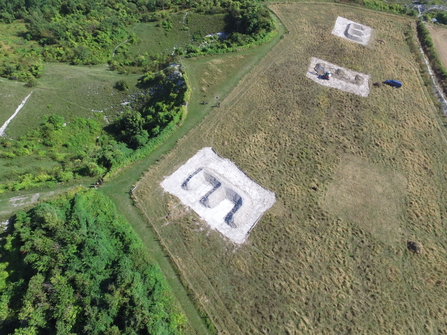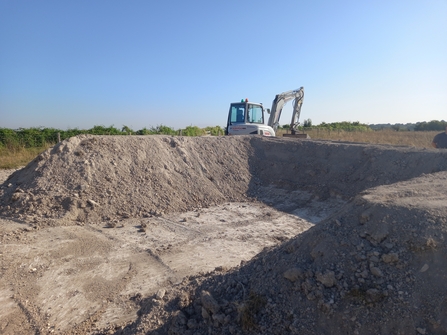A key project for our Wildlife Trust this year has been the launch of the Banking on Butterflies project. This innovative and ambitious project is the first of its kind and is testing the creation of butterfly banks to help a range of species in a changing climate. What makes this project especially important is the detailed surveys before and after the banks are built. By working in partnership with the University of Cambridge, we can make sure that our species conservation is evidence-led and share our findings with the wider conservation movement.
Banking on Butterflies - Project Update
Arial view of the banks being built at our Totternhoe Nature Reserve, each bank faces a different direction
Building the Banks
In early September, the day we had been eagerly anticipating arrived and the digger was delivered. The contractors got straight to work and over the course of eight days built four banks at our Totternhoe reserve and a complimentary four banks at our Pegsdon reserve. The banks reached an impressive height but due to the dry conditions, need to be added to early next year to reach their full potential. Each bank faces a different direction to provide different degrees of shelter and shade so that we can test their effectiveness.

Arial view of the banks being built at our Totternhoe Nature Reserve, each bank faces a different direction
Baseline Information
Before the installation of the banks, we carried out a programme of baseline surveys on the sites so we can establish how effective the banks are. These included:
- Dataloggers – these collect baseline information about the variation in temperature across the area and enable us to link this to changes in plants and invertebrates.
- Plant surveys – we recorded the plants within 88 plant quadrats per site, recording over 80 plant species. This shows that there is a good seedbank on the sites. The composition of plants on the site is likely to change over time so we will continue to carry out plant surveys in future years. It is hoped that key larval food plants for butterflies will increase on the sites due to the creation of bare earth.
- Butterfly surveys -we carried out regular butterfly surveys of the sites so we can see how the banks affect which species use the areas, the abundance of butterflies and how they are distributed within the trial areas. We caught a subset of the butterflies to measure their body temperatures compared to the surrounding environment, this is so we can test how effective the banks are at helping the butterflies warm-up and cool down when they need to. In total, we recorded over 500 butterflies of 21 species during our survey work and took the temperature of 335 butterflies.
- Ground-dwelling invertebrate surveys - we have also been carrying out baseline surveys of ground-dwelling invertebrates as they often operate at microhabitat scales and will be really important in telling us how well the banks are functioning.

Closeup of one of the butterfly banks. This photo shows that some aspects of the bank will be in the sun, with other aspects in the shade at any one time. Monitoring of these banks will continue into the future.
What is Next?
We have now carried out all of our survey work for the year so are now focussing on analysing the baseline information and showcasing our magnificent banks. We will shortly be releasing dates for a series of events where you can come see the banks and learn about why they are so important. We will also be carrying out some habitat management works at our Totternhoe reserve to link up two important gullies for the Duke of Burgundy butterfly. We will continue to work with the University of Cambridge to monitor these banks in future years and look for future locations to create more banks.
Finding out More
You can find out more about this exciting project on our Banking on Butterflies webpage. The project was also recently featured on BBC Breakfast and you can see this footage here.
This project has been supported by The Evolution Education Trust through the Cambridge Conservation Initiative's Knowledge-Exchange Studentship programme, and the People's Postcode Lottery's Nature-based Solutions Fund.

